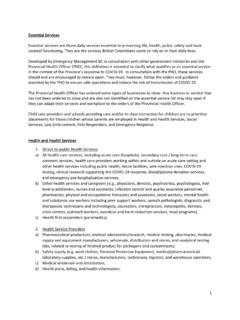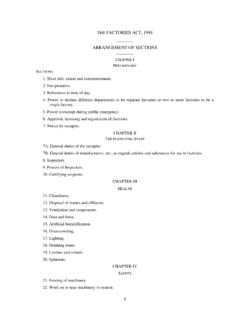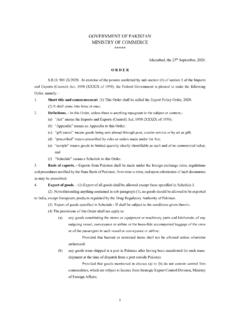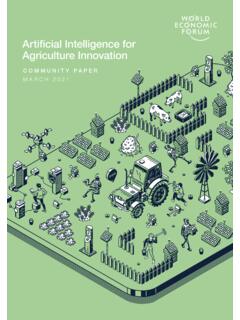Transcription of THE ARMED FORCES COVENANT - GOV.UK
1 THE ARMED FORCES COVENANT THE ARMED FORCES COVENANT An Enduring COVENANT Between The People of the United Kingdom Her Majesty s government and All those who serve or have served in the ARMED FORCES of the Crown And their Families The first duty of government is the defence of the realm. Our ARMED FORCES fulfil that responsibility on behalf of the government , sacrificing some civilian freedoms, facing danger and, sometimes, suffering serious injury or death as a result of their duty. Families also play a vital role in supporting the operational effectiveness of our ARMED FORCES . In return, the whole nation has a moral obligation to the members of the Naval Service, the Army and the Royal Air force , together with their families. They deserve our respect and support, and fair treatment. Those who serve in the ARMED FORCES , whether Regular or Reserve, those who have served in the past, and their families, should face no disadvantage compared to other citizens in the provision of public and commercial services.
2 Special consideration is appropriate in some cases, especially for those who have given most such as the injured and the bereaved. This obligation involves the whole of society: it includes voluntary and charitable bodies, private organisations, and the actions of individuals in supporting the ARMED FORCES . Recognising those who have performed military duty unites the country and demonstrates the value of their contribution. This has no greater expression than in upholding this COVENANT . The ARMED FORCES COVENANT 1 GUIDANCE ON THE ARMED FORCES COVENANT Figure 1: The COVENANT Diagram ArmedForces Community government Nation The ARMED FORCES COVENANT This document accompanies the ARMED FORCES COVENANT and provides guidance on how it is to be put into effect, by describing: A. The parties to the COVENANT . B. A definition of the ARMED FORCES Community. C. The scope of the COVENANT , by outlining the areas in which it can be expected to apply.
3 D. Obligations and principles which flow from the COVENANT . This guidance note is available for the use of any organisation government Departments, the ARMED FORCES , local authorities, charitable bodies etc which wishes to apply the COVENANT to its particular circumstances. It will be updated as necessary. The guidance note does not describe the actions being taken by the UK government to support the ARMED FORCES COVENANT . These are set out in a separate document, entitled The ARMED FORCES COVENANT : Today and Tomorrow . The ARMED FORCES COVENANT 2 A. PARTIES TO THE ARMED FORCES COVENANT The ARMED FORCES COVENANT is a COVENANT between the ARMED FORCES Community, the Nation and the government . Figure 2, building on the core COVENANT diagram, shows the place occupied by different groups in this context . It illustrates that some bodies and individuals are associated mainly with one role, but others have more than one role.
4 The dual role of the Chain of Command, as both a part of the machinery of government and at the heart of each of the Services, is especially important to the effective operation of the COVENANT . Voluntary and charitable bodies are part of civil society, but also embody the ARMED FORCES Community at commemorative events. A more detailed definition of how the ARMED FORCES Community is made up is contained in the next section. Figure 2: Parties to the COVENANT Serving Personnel, Families, Veterans, Bereaved Voluntary and Chain of Charitable Command Bodies Civil Society, Departments Private (MOD, Whitehall, Organisations, Devolved), Local Individuals Service Providers The Crown ArmedForces Community government Ntion aThe ARMED FORCES COVENANT The ARMED FORCES COVENANT 3 B. DEFINITION OF THE ARMED FORCES COMMUNITY The ARMED FORCES Community is defined, for the purposes of the ARMED FORCES COVENANT , as including all those towards whom the Nation has a moral obligation due to Service in HM ARMED FORCES .
5 Inclusion in the community is neither dependent on nor limited by strict criteria, nationality, or legal definitions, and it does not confer any legal rights. The whole of this community is covered by the COVENANT and the obligations and principles which flow from it. The obligations are owed to the ARMED FORCES Community as individuals, as well as collectively. Being part of this community, of some 10 million people, entitles an individual to recognition and sometimes to support. However the level of support made available will vary. It will take into account the need for assistance, and may also reflect what an individual has contributed through Service. Inclusion in the community does not, therefore, mean identical entitlement to support. The ARMED FORCES Community includes: Regular Personnel Individuals currently serving as members of the Naval Service (including the Royal Navy and Royal Marines), Army or Royal Air force .
6 Reservists Volunteer Reservists, who form the Royal Naval Reserve, Royal Marine Reserve, Territorial Army and the Royal Auxiliary Air force , and Regular Reservists, who comprise the Royal Fleet Reserve, Army Reserve and Royal Air force Reserve. Veterans Those who have served for at least a day in HM ARMED FORCES , whether as a Regular or as a Reservist. Families of Regular Personnel, Reservists and Veterans The immediate family of those in the categories listed above. This is defined as spouses, civil partners, and children for whom they are responsible, but can where appropriate extend to parents, unmarried partners and other family members. Bereaved The immediate family of Service Personnel and veterans who have died, whether or not that death has any connection with Service. Levels of Support As noted above, support to the ARMED FORCES Community will reflect the needs and commitment of individuals within that community and the moral obligation of society towards them.
7 However it will generally be cumulative in nature, with members of certain groups receiving more levels of support than others. This is illustrated in Figure 3. Although a broad representation of this type can only be indicative, it shows for example that the support available to serving personnel would normally be in three areas recognition and gratitude, positive measures to prevent disadvantage, and a financial package. Reservists are in a special position, as although they receive the same level of support as their Regular counterparts when mobilised, the commitment they are making when not mobilised must be recognised. The Reservist has a greater liability than the wider civilian The ARMED FORCES COVENANT 4 population and they should be fully supported in meeting the additional challenges they face. Figure 3: Levels of Support Available Special Treatment Financial Package Positive Measures to Prevent Disadvantage Recognition and Gratitude Any form Families Serving Injured of Service Personnel Personnel Reservists Veterans and Injured (not mobilised) Families Veterans (Pensions) Bereaved due to Service The Supporting Civilian Community Beyond the ARMED FORCES Community, and outside the scope of the ARMED FORCES COVENANT , are other groups which play an important role in meeting defence objectives.
8 These groups carry out an extremely wide range of functions, and include (but are not limited to) members of the Merchant Navy, the Royal Fleet Auxiliary, other defence civilians and contractor staff; cadets and the adult volunteers who support them; and the extended families of Serving personnel. All supporting civilians, in very different ways, make valuable contributions for which they deserve recognition and in some cases support. Some groups support the ARMED FORCES directly, consistent with the Whole force Concept. When members of these groups are deployed alongside members of the ARMED FORCES , they are entitled to increased levels of care and support, including in the event of injury or death, and often on a comparable basis to their ARMED FORCES colleagues. The ARMED FORCES COVENANT 5 C. SCOPE OF THE COVENANT The ARMED FORCES COVENANT sets a framework for how the ARMED FORCES Community can expect to be treated, but it is not possible to specify in detail how it should be applied in every case and at every time.
9 The demands of Service and other constraints may prevent these expectations and aspirations being met in some circumstances. However the COVENANT should influence policy, service delivery and standards in the areas and ways set out below. In many cases these will be a responsibility of Central government Departments and Devolved Administrations but, in other cases, responsibility will lie with local service providers or organisations within the voluntary or commercial sectors. Particular attention will be required when public services are subject to reform or to greater local control. This section describes the expectations and aspirations implicit in the ARMED FORCES COVENANT , but not the specific actions being taken to achieve them. For the UK government , these actions are being published separately in The ARMED FORCES COVENANT : Today and Tomorrow . 1. Terms and Conditions of Service Service personnel should be sustained and rewarded by Terms and Conditions of Service (TACOS) which recognise the freedoms and choices that they have voluntarily given up.
10 These TACOS should be fair to personnel and wherever possible give flexibility to match family circumstances, whilst meeting the needs of the MOD and conforming to wider government policy. They will be kept under regular review by the MOD. The terms under which individuals serve, such as enlistment and engagements, are binding in every sense. The conditions offered, in return for the commitments and risks to which Service personnel are subject, should be fair in terms of both the financial and non-financial package. The recommendations of an independent body should constitute an integral part of the process used to determine pay. 2. Healthcare The ARMED FORCES Community should enjoy the same standard of, and access to, healthcare as that received by any other UK citizen in the area they live. For Serving personnel, including mobilised Reservists, primary healthcare is provided by the MOD, whilst secondary care is provided by the local healthcare provider.

















